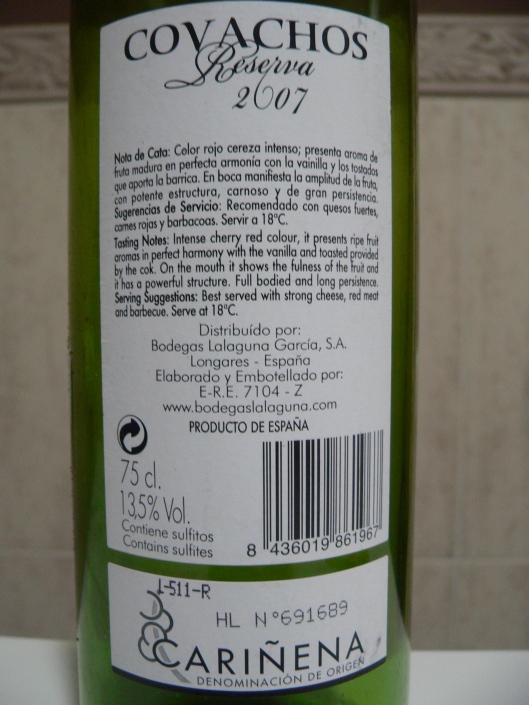Tags
Crianza, Denominacion de Origen, Gran Reserva, Reserva, Rioja, Spain, wine
A little help for those of you that consume Spanish wine and aren´t sure exactly what all that information on the bottle means.
Here is a sample front label from a bottle of Marques de Caceres. It one of the easiest bottles of Spanish wine to find outside of Spain and always a good choice. Great value (good quality, decent price), but that´s another discussion… I am here to talk about what everything on a label means exactly for those that don´t know (bear with me if you do).
So… what all is on the label? Pretty simple right, but let’s make sure.
Marqués de Caceres is the name of the wine…that was easy (sometimes it’s not and I’ve seen errors more than once on wine lists outside of Spain with transposed names of wines, grapes, locations and regions….)
Crianza 2007, well obviously it’s a 2007 vintage, but what is that Crianza word/name/????
Well Crianza refers to the aging. There are specific terms for different aging of wines in Spain. In general, you see one of four different things on a bottle that let you know how long the wine was aged both in a wooden cask and in a glass bottle. The stipulations vary by wine region and between red and white wines. Just to keep it simple, here are the stipulations for Rioja reds (good general rule of thumb).
1. Bottles without one of the three terms below indicate the wine either wasn’t aged in a cask at all or not enough to meet the minimum labeling requirements below.
2. Crianza – aged between 6 and 12 months in a cask then in a bottle for a total of 24 months of total aging (a 2010 wine cannot be sold until 2012 as a Crianza)
3. Reserva – aged minimum 12 months in a cask then in a bottle for a total of 36 months of aging (a 2010 wine cannot be sold until 2013 as a Reserva)
4. Gran Reserva – aged minimum of 24 months in a cask and an additional 36 months minimum in a bottle (a 2010 wine cannot be sold until 2015 as a Gran Reserva).
Only the very best vintages are allowed to be used for Gran Reservas. There are some wineries that won’t lable their wines as Gran Reservas even if they’ve met the minimum aging requirements, if they don’t feel the wine deserves that denomination (Marques de Vargas is a winery that does this for example)
At the bottom of the label is the term “Denominacion de Origen Calificada”, meaning the wine is part of a regulated wine region, in this case Rioja (each wine region has a regulatory sticker that goes on the back of the bottle see the picture below).
“Embotellado por Union Viti-Vinicola, S.A.” tells you the bottler or wine company.
Cenicero is the town in Rioja where the winery is located, in España (Spain).
There is a description of the wine and variety of grape used, in this case Tempranillo. The bottom label is what certifies it is a Rioja and that it is indeed a Crianza from 2007.
Here is another example, can you tell me where the wine is from and how long it was aged (more or less)?
Just a few tips that might help you the next time you go pick up a bottle of Spanish Wine. Crianza, Reserva and Gran Reserva each indicate something different, now you know. Enjoy your wine! 😉





Pingback: Market Research in Ribera del Duero – Part 1 | An American in Corrales
Thanks so much for posting this… It’s nice to have it explained properly. 🙂